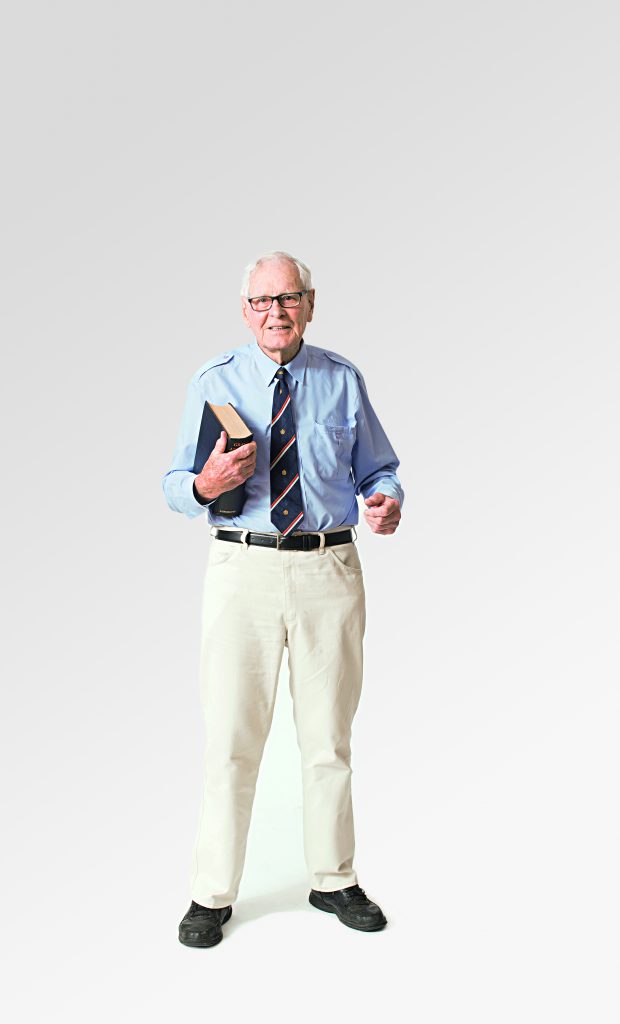Driving ambitions
Donald Hossack OBE PSM (MB BS 1954, BA 1975, MD 2006, Trinity College) overcame dyslexia to become a world-renowned surgeon who helped bring about landmark road safety legislation mandating the wearing of seat belts and alcohol breath-testing. His daughter, Rebecca Hossack (LLB 1978), owns three galleries in New York and London, where she now lives, and is a long-time supporter of Aboriginal art. They spoke to Erin Munro (BA 2006).
Donald: My parents were working class Scottish migrants to Melbourne. I was born in 1926 with undiagnosed dyslexia which caused me misery and stress. By the age of 13, I could no longer bear the humiliation and left school, taking a series of menial jobs.
I was aware there was no future for me in any of them, but I had a stroke of luck. A friend told me of a position available as a laboratory assistant at Melbourne University’s zoology department. The war was on and the technicians had gone off to fight.
I was interviewed by Professor Agar who, despite my lack of any qualifications and being uneducated, decided to give me a trial. So began one of the happiest periods of my life. I worked hard and loved every aspect of my job, particularly collecting specimens for microscopy from the Botanic Gardens’ ponds.
After 18 months, Professor Agar called me and asked where I saw my future. I said I’d like to be a doctor, as I was working alongside medical students and loving what they were doing.
So I went to a college in the city and said I wanted to do physics, chemistry, biology, botany, English and German to intermediate standard in one year at night school. I developed a means whereby I could penetrate my dyslexia and at the end of the year, to everyone’s surprise, I passed.
Professor Agar called me and said, “Laddie, we believe you have shown you have the intelligence and the determination to become a doctor. We’ll do everything we can at the University to help.”
After six years of study, I had all the qualifications. I started doing autopsies for the coroner on people who had been killed in road accidents, and wrote articles on what was causing these deaths.
At the same time, the College of Surgeons started the Road Trauma Committee to work out the causes of deaths on the road and how to prevent them. When my first article was published, they came to see me and asked if I would join them.
I think my contribution was significant, because other people had the idea but I had the figures to convince the government to bring in the legislation. There were 1000 people killed on the roads annually, but since my article was published, it has dropped by about 700.
I talk to everybody, all my children, about the significance of the University of Melbourne to me. I used to take Rebecca as a little girl for walks around the campus, before she herself studied there.
Rebecca was a very clever young girl and very determined. I think that my career, whether she’s aware of it or not, influenced her, because she developed a work ethic of great determination and strength and persistence.
Since I was young I have loved the National Gallery in Melbourne, and I used to take Rebecca there. She was exposed to the great collection at a very early age and she responded to it. She had a great eye and she understood it intuitively. I think it’s a great shame that she lives so far away, though I think what she’s accomplished is marvellous.
Rebecca: We all knew about our father’s difficult start, but the University was always like his sacred site. Every week he used to take me there and we would go swimming in the Beaurepaire Pool. He would tell me about his different experiences and we’d go past the laboratory where he’d worked.
There was no option in my mind that I could go anywhere else, and Melbourne University was a sort of El Dorado to which we all aspired. My plan was to be an actress and I only did law because my parents said it’s better to get a professional qualification under your belt. And when I went to university, dad decided to do a BA, so often we would be sitting next to each other in the same class.
And then I went to London to study for the bar to be a barrister, but my secret plan was to go and look at all the paintings in the National Gallery. Because if you study art history in Australia, you look at everything on slide and you don’t actually see the real size of the pictures.
One day, I was riding my bicycle down the street in central London, and it was a beautiful sunny day – very unusual for London. And I saw an empty shop and it said ‘Lease for sale, no premium’, because in those days you had to pay a lot of money just to get the option to pay a lease. There was a man outside the shop hosing down the pavement, and I asked, “Do you know anything about this?” He said it was his, and I said, “Oh, great! I want to start an art gallery.”
If it had been a rainy day, I wouldn’t have done that because he wouldn’t have been out there. Suddenly, I’d signed a lease for 20 years. I didn’t know anybody and I didn’t really know anything, but I knew I loved art, and I was particularly in love with Aboriginal art.
In 1998, I opened my gallery in Charlotte Street, Fitzrovia. Then, 10 years ago, I opened the big, three-storey gallery on Fitzroy Square in Central London, and eight years ago I opened the New York gallery in SoHo. The British Museum has bought a lot of art from us, and I also lecture for the Fine Art Society of Britain. My subject is Aboriginal art, and it’s been a wonderful journey educating the British people on the topic.
Over the past 30 years, I’ve been privileged to have had pretty much all the major Aboriginal artists come and visit us. Clifford Possum Tjapaltjarri used to come and I got him to meet the Queen.
I’m going back to Australia for the Garma Festival with Melbourne University – with the medical faculty and Professor Marcia Langton – this August. We’re working on some projects on how to enhance the dialogue around Aboriginal art.
I think that’s something my father’s always instilled in me: a love of paintings and beauty, and nature, too. Every Saturday he used to take me to the Melbourne Botanic Gardens and we’d get some pond water and then we’d go home and look at all the animal life through a microscope. Still, when I go back and see him, the first thing we’ll do is he’ll take me out to his garden.




